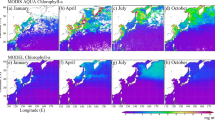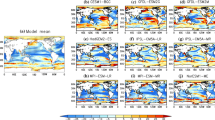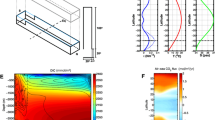Abstract
A simplified physical model is proposed in this article to describe differences among basins in substance distributions which were not well described by previous simplified models. In the proposed model, the global ocean is divided into the Pacific/Indian Ocean (PI), the Atlantic Ocean (AT), the Southern Ocean and the Greenland/Iceland/Norwegian Sea. The model is consisted of five physical parameters, namely the air-sea gas exchange, the thermohaline circulation, the horizontal and vertical diffusions, and the deep convection in the high-latitude regions. Individual values of these parameters are chosen by optimizing model distribution of natural 14C as a physical tracer. The optimal value for a coefficient of vertical diffusion in the low-latitude region is 7.5 × 10−5 [m2s−1]. Vertical transports by the Antarctic Bottom Water and the North Atlantic Deep Water are estimated at 1.0 Sv and 9.0 Sv. Global-mean air-sea gas exchange time is calculated at 9.0 years. Using these optimal values, vertical profiles of dissolved inorganic carbon without biological production in PI and AT are estimated. Oceanic responses to anthropogenic fluctuations in substance concentrations in the atmosphere induced by the industrialization and nuclear bomb are also discribed, i.e., the effects appear significantly in AT while a signal is extremely weak in PI. A time-delay term is effective to make the PI water older near the bottom boundary.
Similar content being viewed by others
Reference
Anderson, L. and J. L. Sarmiento (1995): Global ocean phosphate and oxygen simulations. Global Biogeochemical Cycles, 9, 621–636.
Bacastow, R. and E. Maier-Reimer (1990): Ocean-circulation model of the carbon cycle. Clim. Dyn., 4, 95–125.
Bacastow, R. and E. Maier-Reimer (1991): Dissolved organic carbon in modeling oceanic new production. Global Biogeochemical Cycles, 5, 71–85.
Broecker, W. S. and T.-H. Peng (1982): Tracers in the Sea. Lamont-Doherty Earth Observatory, Palisades, N.Y., 691 pp.
Bryan, F. (1987): Parameter sensitivity of primitive general circulation models. J. Phys. Oceanogr., 17, 970–985.
England, M. H. (1995): Using chlorofluorocarbons to assess ocean climate models. Geophys. Res. Lett., 22, 3051–3054.
Hoffert, M. I., A. J. Callegari and C.-T. Hsieh (1980): The role of deep sea heat storage in the secular response to climatic forcing. J. Geophys. Res., 85, 6667–6679.
Joos, F., U. Siegenthaler and J. L. Sarmiento (1991): Possible effects of iron fertilization in the Southern Ocean on atmospheric CO2 concentration. Global Biogeochemical. Cycles, 5, 135–150.
Ledwell, J. R., A. J. Watson and C. S. Law (1993): Evidence for slow mixing across the pycnocline from an open-ocean tracer-release experiment. Nature, 364, 701–703.
Mehrbach, C., C. H. Culberson., J. E. Hawley and R. M. Pytkowicz (1973): Measurement of the apparent dissociation constants of carbonic acid in seawater at atmospheric pressure. Limnol. Oceanogr., 18, 897–906.
Morris, M., N. Hogg and W. B. Owens (1997): Diapycnal mixing estimated from advective budgets in the deep Brazil Basin. International WOCE Newsletter, 28, 23–28.
Munk, W. H. (1966): Abyssal recipes. Deep-Sea Res., 13, 707–730.
Najjar, R. G., J. L. Sarmiento and J. R. Toggweiler (1992): Downward transport and fate of organic matter in the ocean: simulations with a general circulation model. Global Biogeochemical Cycles, 6, 45–76.
Oeschger, H., U. Siegenthaler, U. Schotterer and A. Gugelmann (1975): A box diffusion model to study the carbon dioxide exchange in nature. Tellus, XXVII, 168–192.
Quay, P. D., B. Tilbrook and C. S. Wong (1992): Oceanic uptake of fossil fuel CO2: Carbon-13 evidence. Science, 256, 74–79.
Sarmiento, J. L. and J. C. Orr (1991): Three-dimensional simulations of the impact of Southern Ocean nutrient depletion on atmospheric CO2 and ocean chemistry. Limnol. Oceanogr., 36, 1928–1950.
Sarmiento, J. L., J. C. Orr and U. Siegenthaler (1992): A perturbation simulation of CO2 uptake in an ocean general circulation model. J. Geophys. Res., 97, 3621–3645.
Schmitz, W. J. (1995): On the interbasin-scale thermohaline circulation. Rev. Geophys., 33, 151–173.
Shaffer, G. and J. L. Sarmiento (1995): Biogeochemical cycling in the global ocean, 1. A new analytical model with continuous vertical resolution and high-latitude dynamics. J. Geophys. Res., 100, 2659–2672.
Siegenthaler, U. (1983): Uptake of excess CO2 by an outcrop-diffusion model of the ocean. J. Geophys. Res., 88, 3599–3608.
Siegenthaler, U. and F. Joos (1992): Use of a simple model for studying oceanic tracer distributions and the global carbon cycle. Tellus, 44B, 186–207.
Siegenthaler, U. and Th. Wenk (1984): Rapid atmospheric CO2 variations and ocean circulation. Nature, 308, 624–626.
Wanninkhof, R. (1992): Relationship between wind speed and gas exchange over the ocean. J. Geophys. Res., 97, 373–382.
Weiss, R. F. (1974): Carbon dioxide in water and seawater: The solubility of a non-ideal gas. Mar. Chem., 2, 203–215.
Yamanaka, Y. and E. Tajika (1996): The role of the vertical fluxes of particulate organic matter and calcite in the oceanic carbon cycle: Studies using an ocean biogeochemical general circulation model. Global Biogeochemical Cycles, 10, 361–382.
Yamanaka, Y. and E. Tajika (1997): Role of dissolved organic matter in the marine biogeochemical cycle: Studies using an ocean biogeochemical general circulation model. Global Biogeochemical Cycles, 11, 599–612.
Author information
Authors and Affiliations
Rights and permissions
About this article
Cite this article
Fujii, M., Ikeda, M. & Yamanaka, Y. Roles of Physical Processes in the Carbon Cycle Using a Simplified Physical Model. Journal of Oceanography 56, 655–666 (2000). https://doi.org/10.1023/A:1011173616231
Issue Date:
DOI: https://doi.org/10.1023/A:1011173616231




